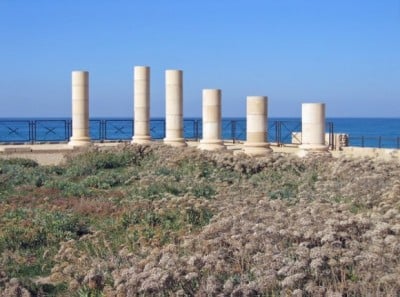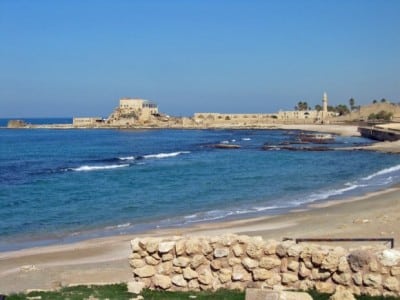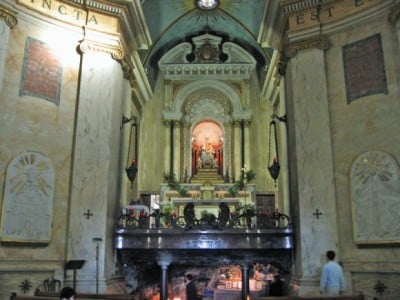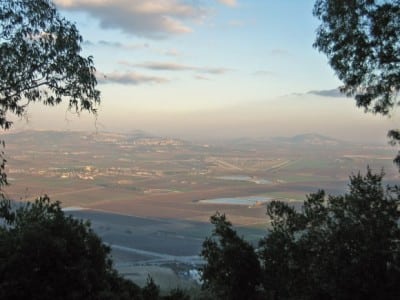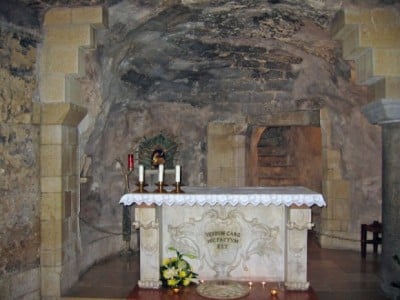Ruins of Herod’s Palace at Caesarea
Today we loaded up the bus bright and early and headed north for a 3 day tour of Galilee. We’ll be going back for 5 more days in January, so this was just a taste. Our first stop was the ruins of the ancient city of Caesarea. This place is right on the Mediterranean Sea and is absolutely beautiful. The city was one of the major port cities in the first century, with a harbor that could hold 200 ships. There are lots of ruins including a Roman theater, hippodrome, and aqueduct. Also located here is what is beginning to be a recurring theme of our field trips, a palace of King Herod the Great. It seems he had palaces everywhere. However, this time he actually lived here for a while (See Acts 12:19). From the religious side of things, this city has a very important history. It was here in Caesarea that St. Paul was held prisoner before being sent to Rome to stand trial. (See Acts 25).
From Caesarea we continued up the coast to Mt. Carmel and the port city of Haifa. From the top of Mt. Carmel we had an absolutely gorgeous view of the Bay of Haifa and the surrounding town. You might recall here about this place on the news this summer as Lebanon was firing rockets into this town. Next, we visited the Carmelite monastery on top of Mt. Carmel and the church dedicated to Our Lady known as Stella Maris. Like most churches here in the Holy Land, the present church was built in modern times on top of a Crusader church which was built on top of a Byzantine church. It is from this spot that Elijah is said to have had the vision of the small cloud that grew into a storm which the Carmelites came to see as an image of Mary (1 Kings 18:42). Inside the church, under the sanctuary is the cave where Elijah hid from King Ahaz and Jezebel.
Stella Maris Carmelite Church on Mt. Carmel
Cave of Elijah Below
It turns out that Mt. Carmel is not just a single pointy kind of mountain like you might envision, but a long ridge. So we followed the top of the mountain inland for a few miles to the highest point. Here there is also a Carmelite monastery that is located on the site where Elijah had his famous duel with the prophets of Baal (1 Kings 18:20-40). We also had a very nice view of the surrounding country. We could see the very lush and green Jezreel Valley below, as well as Mt. Tabor in the distance where we will go tomorrow. After seeing the large desert around Bethlehem, it was a very nice change to see how green and beautiful the northern areas are. I can see why Jesus would have liked to live here.
View of Jezreel Valley from Mt. Carmel
It was evening by this time, so we headed on to Nazareth where we would be staying for the next two nights. It turns out that the convent where we are staying is right next to the Church of the Annunciation. This church is again, a modern church, built over a Crusader church, built over a Byzantine church, and this time built over a first century home. All of the ruins are contained inside the new church and you can actually see all the different structures. The most important thing is the first century cave that was the home of Mary. It was here that the Angel Gabriel appeared to Mary. One thing that is frustrating about the Church of the Nativity in Bethlehem is that so much has been added to the cave where Jesus was born that it can be hard to envision it the way it was originally. In the Church of the Annunciation, however, you really feel like you’re walking into Mary’s house when you go there. I was so overwhelmed to be in this place that I couldn’t even enter the house right away. I just knelt down at the entrance and prayed the first joyful mystery of the rosary for a while. St. John’s Gospel beautifully tells us that “The Word Became Flesh and Dwelt Among Us.” This phrase is written in Latin on the front of the church. However, down in the grotto, under the altar that is in Mary’s house, you will find instead the quote, in Latin, “The Word Became Flesh HERE”. This was probably the most amazing experience of the entire pilgrimage so far. Unlike the grotto of the Nativity in Bethlehem with all the people, it was quiet here in Nazareth and I was just completely taken over by the thought of Mary’s encounter with Gabriel in this very place. Right before my eyes was the exact location where God became Man. I could almost see the encounter taking place in front of me and found myself listening longingly for Mary’s humble reply to the angel. I can’t really describe it adequately in words. This is a special place. I could have stayed there for much longer, but we have another full day planned for tomorrow.
Grotto of the Annunciation, Mary’s House in Nazareth
“The Word Became Flesh HERE”

